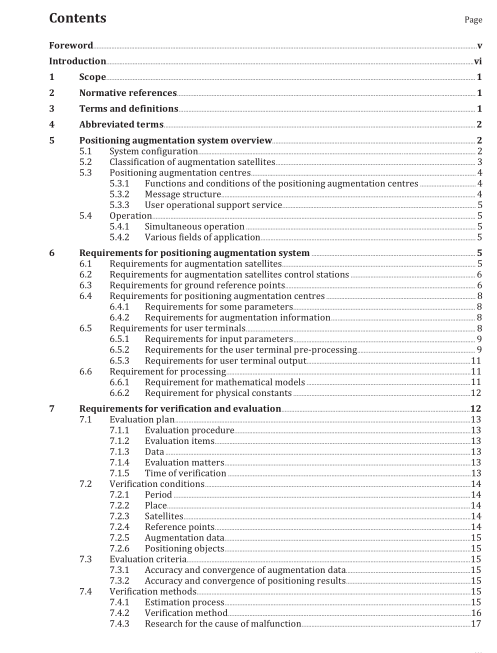BS ISO 18197:2015 pdf download.Space systems — Space based services requirements for centimetre class positioning
This International Standard defines the requirements for the wide area centimetre class positioning system by broadcasting augmentation data through satellites as follows.
— Centimetre class positioning
According to the progress of requirements for positioning services such as automatic farming,mapping and others, centimetre class positioning is very useful.
— Wide area positioning
It is quite effective to broadcast augmentation data through satellites for users over wide area such as a square, more than 1,000 km each side, anytime and anywhere. Even if this area is short of data network, additional ground network facilities are not needed. In addition, as ranging signal and augmentation data can be received from satellite broadcasting at the same time, it is unnecessary for user terminals to receive the signal such as transmitted by ground network.
— Real-time property
The user terminals need to resolve the ambiguity in real-time, using augmentation data broadcast from satellites or other means, for the realization of centimetre class positioning. On the other hand,the provider sides have to broadcast augmentation data such that the terminal sides are able to resolve the ambiguity in real-time.
2 Normative references
No normative references cited in this document.
3 Terms and definitions
For the purposes of this document, the following terms and definitions apply.
3.1 fixing
determining the integer number of carrier phase waves when calculating the position by use of carrier phase measurement
Note 1 to entry: This should be distinguished from the case of determining the desired value by convergence of continuous quantities when calculating the position by use of pseudorange measurement.
3.2 sustainability
measurement anomaly at some reference point should make no influence on the augmentation data generation
4 Abbreviated terms
BDS BeiDou Navigation Satellite System
CEP Circular Error Probable
DOP Dilution of Precision
ECEF Earth-Centred Earth-Fixed
ECI Earth-Centred Inertial
GEO Geostationary Earth Orbit
GLONASS Global Navigation Satellite System
GNSS Global Navigation Satellite System
GPS Global Positioning System
IGSO Inclined Geosynchronous Satellite Orbit
IOD Issue Of Data
IRNSS Indian Regional Navigational Satellite System
ITRF International Terrestrial Reference Frame
ITS Intelligent Transportation System
LEO Low Earth Orbit
MEO Medium Earth Orbit
NED North East Down
NRTK Network Real-Time Kinematics
RTK Real-Time Kinematics
QZS Quasi-Zenith Satellite
QZSS Quasi-Zenith Satellite System
5 Positioning augmentation system overview
5.1 System configuration
Figure 1 shows the typical view of positioning augmentation system of centimetre class. Here, this International Standard does not deal with the ranging signal broadcast from GNSS.
This typical system is configured mainly by the following components:
a) GNSS;
b) augmentation satellites;
c) augmentation satellites control stations;
d) ground reference points;
e) positioning augmentation centres;
f) user terminals.
Each component is explained below.
5.2 Classification of augmentation satellites
An augmentation satellite broadcasts augmentation data, uplinked from the positioning augmentation centres for users over wide area. Augmentation satellites are classified into the following:
a) geostationary earth orbit satellite (GEO);
b) inclined geosynchronous satellite orbit (IGSO);
c) medium or low earth orbit satellite (MEO/LEO).
The overview and features of various augmentation satellites is shown in Table 1.
5.3 Positioning augmentation centres
The augmentation centres make augmentation data using the observation data at the ground reference points. The system sustainability is taken into account when making augmentation data. Some remarks are described below about the functions and conditions, message structure, and user operational support service.
5.3.1 Functions and conditions of the positioning augmentation centres
The functions and conditions of the positioning augmentation centres are as follows.
a) Augmentation data generation
The augmentation centres make augmentation data using the observation data at the ground reference points.
b) Monitoring of operation and measures
The augmentation centres monitor the system operational conditions by analysing data received from augmentation satellites and reference points so as to detect ionosphere disturbance or others.
Based on the result, this International Standard should assess the influence on ranging signal or
communication link and takes proper measures to recover the situation.
c) Detection of satellite signal anomaly
The augmentation centres calculate the predicted error using observation data at the ground reference points. The signal analysis is provided to specify the malfunction satellite.
5.3.2 Message structure
Figure 2 shows the example of message structure of augmentation data broadcast from the augmentation satellite.BS ISO 18197 pdf download.BS ISO 18197 pdf download
